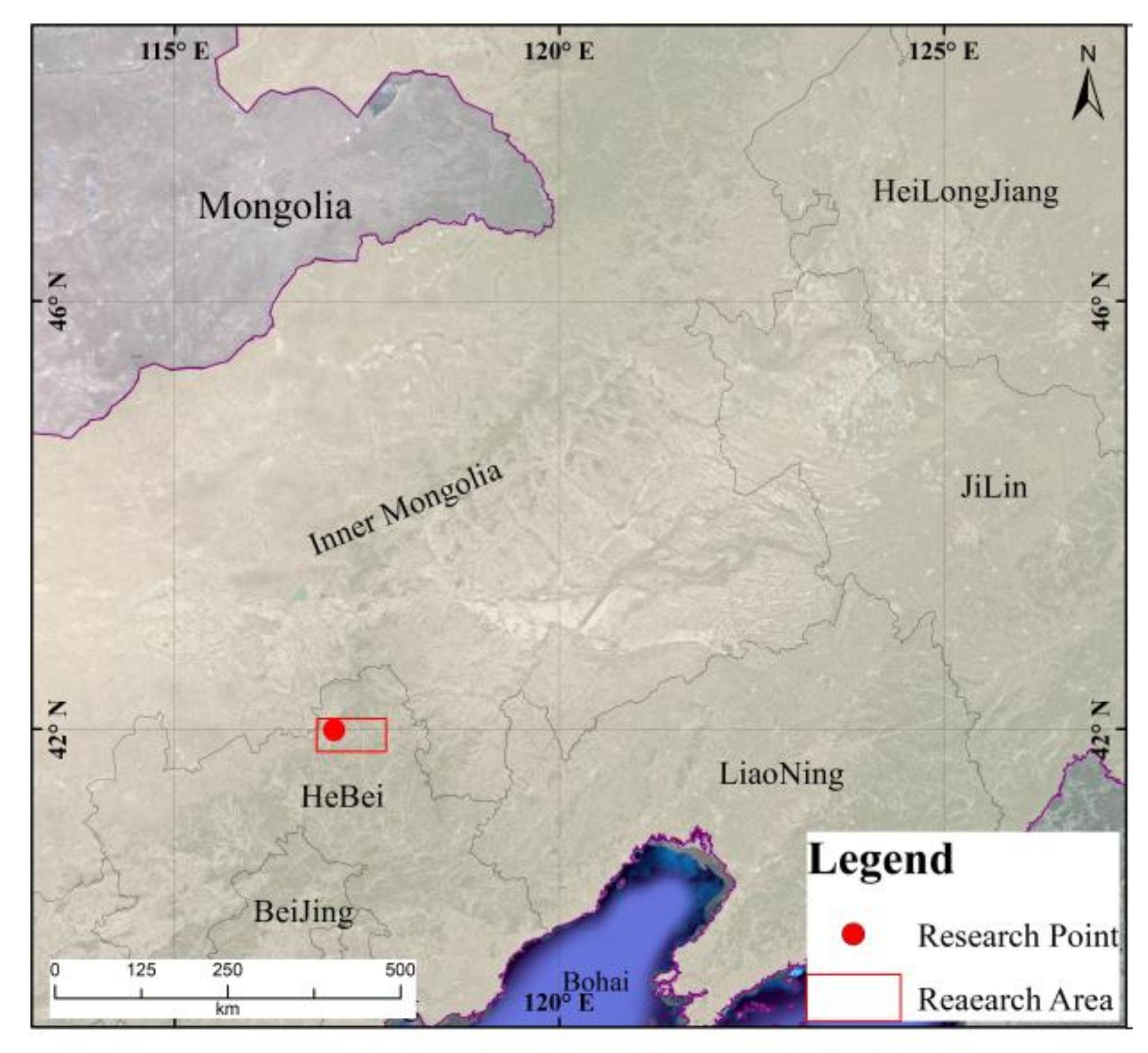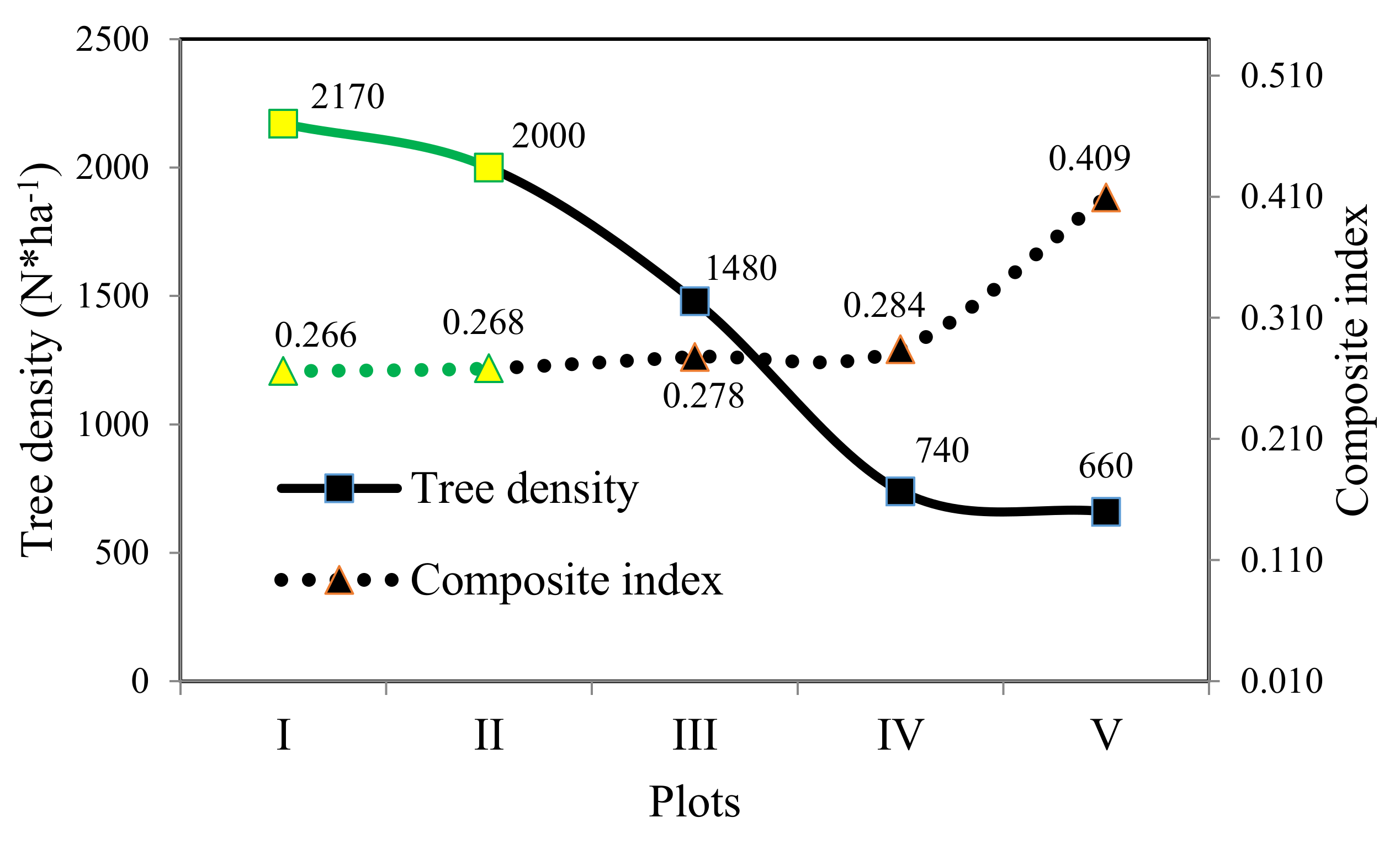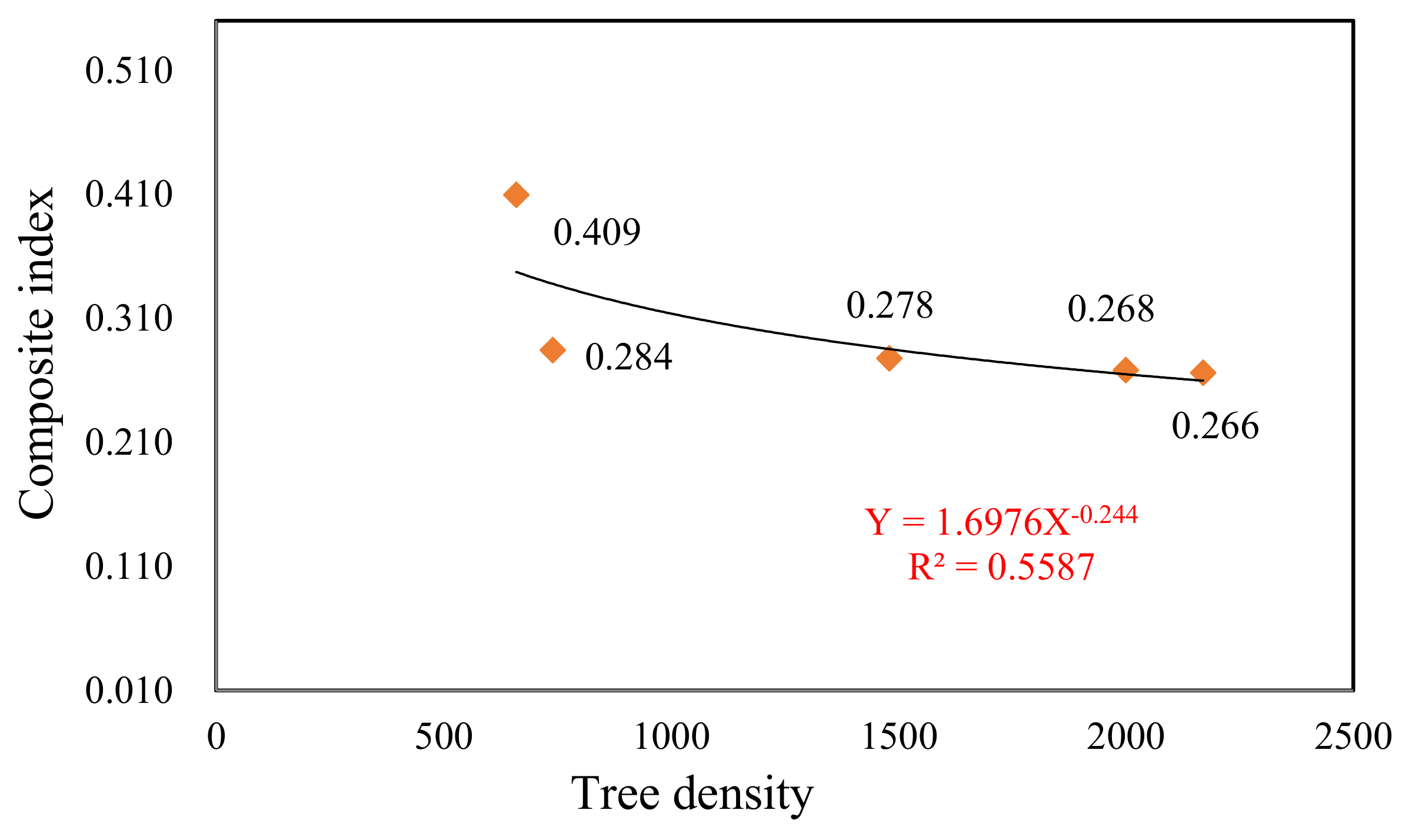Effects of Thinning on the Spatial Structure of Larix principis-rupprechtii Plantation
Abstract
:1. Introduction
2. Materials and Methods
2.1. Study Area
2.2. Sample Plots and Field Survey
2.3. Data Processing
3. Results
3.1. Effects of Thinning on Mingling Degree of Stand
3.2. Effect of Thinning on the Distribution of Uniform Angle Degree
3.3. Effect of Thinning on Neighborhood Comparison
3.4. Effect of Thinning on Opening Degree
3.5. Multiple Comparison and Construction of Composite Spatial Structure Index
4. Discussion
4.1. Response of Forest Spatial Structure to Thinning
4.2. Determination and Evaluation of Thinning Intensity in Structure-Based Forest Management
5. Conclusions
Acknowledgments
Author Contributions
Conflicts of Interest
References
- Hui, G. Studies on the application of stand spatial structure parameters based on the relationship of neighborhood trees. J. Beijing For. Univ. 2013, 35, 1–8. [Google Scholar]
- Pretzsch, H. Analysis and modeling of spatial stand structures Methodological considerations based on mixed beech-larch stands in Lower Saxony. For. Ecol. Manag. 1997, 97, 237–253. [Google Scholar] [CrossRef]
- Pastorella, F.; Paletto, A. Stand structure indices as tools to support forest management: An application in Trentino forests. J. For. Sci. 2013, 59, 159–168. [Google Scholar] [CrossRef]
- Hui, G.Y.; Hu, Y.B. Measuring Species Spatial Isolation in Mixed Forests. For. Res. 2001, 14, 23–27. [Google Scholar]
- Hui, G.Y.; Klaus, V.G.; Matthias, A. A New Parameter for Stand Spatial Structure—Neighbourhood Comparison. For. Res. 1999, 12, 1–6. [Google Scholar]
- Hui, G.Y.; Klaus, V.G.; Matthias, A. The neighborhood pattern—A new structure parameter for describing distribution of forest tree potation. Sci. Silv. Sin. 1999, 35, 37–42. [Google Scholar]
- Hu, Y.B.; Hui, G.Y. A Discussion on Forest Management Method Optimizing Forest Spatial Structure. For. Res. 2006, 19, 1–8. [Google Scholar]
- Zhong, J.F.; Liu, D.L.; Zheng, X.X. The Quantitative Research Progress of Water Conservation Forest’s Structure and Function. Mod. Agric. Sci. 2009, 16, 110–112. [Google Scholar]
- Oliver, C.D. A landscape approach: Achieving and maintaining biodiversity and economic productivity. J. For. 1992, 90, 20–25. [Google Scholar]
- Franklin, J.F.; Spies, T.A.; Pelt, R.V.; Carey, A.B.; Thornburgh, D.A.; Berg, D.R.; Lindenmayer, D.B.; Harmon, M.E.; Keeton, W.S.; Shaw, D.C.; et al. Disturbances and structural development of natural forest ecosystems with silvicultural implications, using Douglas-fir forests as an example. For. Ecol. Manag. 2002, 155, 399–423. [Google Scholar] [CrossRef]
- Carey, A.B.; Elliot, C.E.; Lippke, B.R.; Sessions, J.; Chambers, C.J.; Oliver, C.D.; Franklin, J.F.; Raphael, M.G. Washington Forest Landscape Management Project—A Pragmatic, Ecological Approach to Small Landscape Management; Report No.2; Washington State Department of Natural Resources: Olympia, WA, USA, 1996.
- Tang, M.P. Study on Forest Spatial Structure Analysis and Optimal Management Model; Beijing Forestry University: Beijing, China, 2003. [Google Scholar]
- An, H.; Hui, G.; Zheng, X.; Zhang, T.; Hu, Y.; Meng, Q. Study on the spatial structure of broad-leaved Korean pine forest in the different growth stage. Acta Sci. Nat. Univ. Neimongol 2005, 36, 714–718. [Google Scholar]
- FAO Yearbook of Forest Products; FAO: Rome, Italy, 2015.
- State Forestry Administration. The Results of Seventh National Forest Resources Inventory. 2010. Available online: http://www. Forestry.gov.cn/partal/main/s/65/content-326341.html (accessed on 4 May 2010).
- State Forestry Administration of Forest Resources Management. The seventh national forest resources inventory and the status of the forest resources. For. Resour. Manag. 2010, 39, 1–8. [Google Scholar]
- Gao, G.L.; Ding, G.D.; Xiao, M.; Zhang, L.L.; Ren-Meng, L.; Zhang, X.; Li, W.; Liu, Y. A study on stand visualization of artificial mixed forests. Bull. Soil Water Conserv. 2012, 32, 158–162. [Google Scholar]
- Ma, L.Y.; Li, C.Y.; Wang, X.Q.; Xu, X. Effects of Thinning on the Growth and the Diversity of Undergrowth of Pinus tabulae formis Plantation in Beijing Mountainous. Sci. Silv. Sin. 2007, 43, 1–9. [Google Scholar]
- Zheng, L.F.; Zhou, X.N. Dynamics Effects of Selective Cutting Intensity on the Species Composition and Diversity of Natural Forest. J. Mount. Sci. 2008, 26, 699–706. [Google Scholar]
- An, Y.; Ding, G.D.; Liang, W.J.; Gao, G.L.; He, Y.; Wei, B.; Bao, Y.; Bao, B. Effects of Tending and Thinning on the Community Stability of Pinus tabulae formis Plantation in Rocky Mountain Area of Northern China. J. Sichuan Agric. Univ. 2012, 30, 12–17. [Google Scholar]
- Zhu, J.J.; Li, F.Q.; MatsuzakiI, T.; Gonda, Y. Influence of thinning on regeneration in a coastal Pines thunbergii forest. Chin. J. Appl. Ecol. 2002, 13, 1361–1367. [Google Scholar]
- Bréda, N.; Granier, A.; Aussenac, G. Effects of thing on soil and tree water relations, transpiration and growth in an oak forest (Quercuspetraea (Matt.) Liebl). Tree Physiol. 1995, 15, 295–306. [Google Scholar] [CrossRef] [PubMed]
- An, Y.; Ding, G.D.; Liang, W.J.; Gao, G.L.; He, Y.; Wei, B.; Bao, Y.; Bao, B. Effects of Thinning on the Growth and the Development of Undergrowth of Pinus tabulae formis Plantation in Rocky Mountain Area of North China. Res. Soil Water Conserv. 2012, 19, 86–90. [Google Scholar]
- Liu, Q. Ecological Problems of Subalpine Coniferous Forest in the Southwest of China. World Sci. Technol. R&D 2001, 23, 63–69. [Google Scholar]
- Hu, D.; Wang, R. Exploring eco-construction for local sustainability: An eco-village case study in China. Ecol. Eng. 1998, 11, 167–176. [Google Scholar] [CrossRef]
- Ren, L.N.; Wang, H.Y.; Ding, G.D.; Gao, G.L.; Yang, X.J. Effects of Pinus tabulaeformis Carr. plantation density on soil organic carbon and nutrients characteristics in rocky mountain area of northern China. Arid Land Geogr. 2012, 35, 456–464. [Google Scholar]
- Yao, W.; Hu, J.; Yang, X. Physical Properties of Soil Water in Mixed Forest of Larix principis-rupprechti in Northern Mountain of Hebei Province. Prot. For. Sci. Technol. 2016, 155, 1–3. [Google Scholar]
- Tang, J.W.; Qi, Y.; Xu, M.; Misson, L.; Goldstein, A.H. Forest thinning and soil respiration in a ponderosa pine plantation in the Sierra Nevada. Tree Physiol. 2005, 25, 57–66. [Google Scholar] [CrossRef] [PubMed]
- He, Y.; Ding, G.D.; Liang, W.J.; Zang, Y.T.; Gao, G.L.; An, Y. Influence of stand density on water-holding characteristics of litter layer. J. Northwest A&F Univ. 2012, 40, 68–72. [Google Scholar]
- Zhao, J.C.; Kong, Z.P. Flora of Mulan Weichang in Hebei; Science Press: Beijing, China, 2008; Volume 1, pp. 68–72. ISBN 9787030232151. [Google Scholar]
- Gao, G.L.; Ding, G.D.; Zhang, J.Y.; Ren, L.N.; Zang, Y.T.; Liang, W.J. Spatial Structural Characteristics of Natural Secondary Forest in Rocky Mountain Area of Northern China. Bull. Soil Water Conserv. 2011, 31, 81–85. [Google Scholar]
- Gadow, K. Zur Bestandesbeschreibung in der Forsteinrichtung. Forst Holz 1993, 48, 601–606. [Google Scholar]
- Dong, L.; Liu, Z.; Ma, Y.; Ni, B.; Li, Y. A new composite index of stand spatial structure for natural forest. J. Beijing For. Univ. 2013, 35, 16–22. [Google Scholar]
- Hu, Y.; Bo, H.Y.; Bo, X.H. Structured Forest Management; China Forestry Publishing: Beijing, China, 2007; Volume 1, pp. 56–60. ISBN 9787503847639. [Google Scholar]
- Hao, Y.Q.; Wang, J.X.; Wang, Q.H.; Sun, P.; Pu, C.L. Preview of Spatial Structure of Cryptomeriafortunei Plantation after Stand Improvement. Sci. Silv. Sin. 2006, 42, 8–12. [Google Scholar]
- Gao, G.L.; Ding, G.D.; Ren, L.N.; Zang, Y.T.; Liang, W.J. Application of spatial competition index to the natural secondary forest of rocky mountain area in Northern China. J. Arid Land Resour. Environ. 2012, 26, 134–138. [Google Scholar]
- Lv, Y.; Tan, Y.; Lv, F.; Li, X.; Zhang, J. Research on Thinning Intensity of Natural Secondary Forest—A Case of Schima superba Secondary Forest of Qingshigang Forest Farm. For. Resour. Manag. 2013. [Google Scholar] [CrossRef]
- Tan, Y. The Thinning Intensity Research of Natural Secondary Forest Based on Cutting Index; Central South University of Forestry and Technology: Changsha, China, 2014. [Google Scholar]
- Zhang, E.L. Study on Route of Natural Secondary Forest Management. J. Anhui Agric. Sci. 2015, 43, 77–78. [Google Scholar]
- Wang, A.; Liu, B. Study on Manage of Natural Secondary Forest. Jiangxi For. Technol. 2000, 3, 1–4. [Google Scholar]
- Lei, X.D.; Tang, S.Z. Indicators on structural diversity within-stand: A review. Sci. Silv. Sin. 2002, 38, 140–146. [Google Scholar]
- Pan, Y.; Birdsey, R.A.; Phillips, O.L.; Jackson, R.B. The Structure, Distribution, and Biomass of the World’s Forests. Annu. Rev. Ecol. Evol. Syst. 2013, 44, 593–622. [Google Scholar] [CrossRef]
- Ren, H.; Jian, S.; Lu, H.; Zhang, Q.; Shen, W.; Han, W.; Yin, Z.; Guo, Q. Restoration of mangrove plantations and colonisation by native species in Leizhou bay, South China. Ecol. Res. 2008, 23, 401–407. [Google Scholar] [CrossRef]
- Hui, G.Y.; Hu, Y.B.; Zhao, Z.H. Further discussion on “Structure-based Forest Management”. World For. Res. 2009, 22, 14–19. [Google Scholar]
- Huang, L.; Huo, Y.; Jin, H.; Li, N. Relationship between Neighborhood Comparison and Diameter Growth of Secondary Poplar-birch Forest in the Mountains of North Hebei. For. Resour. Manag. 2014. [Google Scholar] [CrossRef]
- Gao, G.L.; Xin, Z.B.; Ding, G.B.; Li, C.C.; Zhang, J.Y.; Liang, W.; An, Y.; He, Y.; Xiao, M.; Li, W. Forest health studies based on remote sensing: A review. Acta Ecol. Sonica 2013, 33, 1675–1689. [Google Scholar]
- Hao, Z.; Zhang, J.; Song, B.; Ye, J.; Li, B. Vertical structure and spatial associations of dominant tree species in an old-growth temperate forest. For. Ecol. Manag. 2007, 252, 1–11. [Google Scholar] [CrossRef]
- Ma, L.K. Forest vegetation and soil succession the natural process of change. In Proceedings of the TEP Seminar XIII: Trees, Roots, Fungi, Soil (Part 2), Bristol, UK, 20 June 2009. [Google Scholar]
- Riitters, K.; Wickham, J.; O’Neill, R.; Jones, B.; Smith, E. Global-scale patterns of forest fragmentation. Conserv. Ecol. 2000, 4, 1924–1925. [Google Scholar] [CrossRef]
- Wang, J.W.; Hou, M.M.; Huang, L.Y.; Zhang, J.; Zhou, H.-C.; Cheng, Y.-X. Phylogenetic and functional beta diversity in a broadleaved Korean pine mixed forest in Changbai Mountains, northeastern China. J. Beijing For. Univ. 2016. [Google Scholar] [CrossRef]
- Onaindia, M.; Ametzaga-Arregi, I.; Sebastián, M.S.; Mitxelena, A.; Rodríguez-Loinaz, G.; Peña, L.; Alday, J.G. Can understorey native woodland plant species regenerate under exotic pine plantations using natural succession? For. Ecol. Manag. 2013, 308, 136–144. [Google Scholar] [CrossRef]
- Li, J.; Zheng, X. The Forest Health Assessment Indicator System for the Water conservation Forests in Beijing Area. For. Resour. Manag. 2004, 1, 31–34. [Google Scholar]
- Yen, T.M.; Lee, J.S.; Li, C.L.; Chen, Y.T. Aboveground biomass and vertical distribution of crown for Taiwan red cypress 20 years after thinning. Dendrobiology 2013, 70, 109–116. [Google Scholar] [CrossRef]
- Yen, T.M. Relationships of Chamaecyparis formosensis crown shape and parameters with thinning intensity and age. Ann. For. Res. 2015, 58, 323–332. [Google Scholar] [CrossRef]
- Zhang, P.F.; He, W.R.; He, X.; Zhang, J.; Li, Y.M. An approach on forest spatial change in Xishuangbanna. Acta Geogr. Sin. 1999, 54, 139–145. [Google Scholar]
- McElhinny, C.; Gibbons, P.; Brack, C.; Bauhus, J. Fauna-habitat relationships: A basis for identifying key stand structural attributes in temperate Australian eucalypt forests and woodlands. Pac. Conserv. Biol. 2006, 12, 89–110. [Google Scholar] [CrossRef]
- Shu, Y.Q.; Lan, Z.R.; Chen, C.C. Analysis and Simulation of the time-varying property of Forest Spatial Data. Comput. Eng. 2005, 31, 27–29. [Google Scholar]
- Riitters, K.H. Downscaling indicators of forest habitat structure from national assessments. Ecol. Indic. 2005, 5, 273–279. [Google Scholar] [CrossRef]
- Segura, A.; Castaño-Santamaría, J.; Laiolo, P.; Obeso, J.R. Divergent responses of flagship, keystone and resource-limited bio-indicators to forest structure. Ecol. Res. 2014, 29, 925–936. [Google Scholar] [CrossRef]
- McElhinny, C.; Gibbons, P.; Brack, C. An objective and quantitative methodology for constructing an index of stand structural complexity. For. Ecol. Manag. 2006, 235, 54–71. [Google Scholar] [CrossRef]
- Hui, G.; Hu, Y. Application of Neighborhood Pattern in Forest Spatial Structure Regulation. For. Resour. Manag. 2006, 2, 31–36. [Google Scholar]
- Aguirre, O.; Hui, G.; Gadow, K.V.; Jiménez, J. An analysis of spatial forest structure using neighborhood-based variables. For. Ecol. Manag. 2003, 183, 137–145. [Google Scholar] [CrossRef]
- Yue, Y.J.; Yu, X.X.; Li, G.T.; Fan, D.X.; Ye, J.D. Spatial structure of Quercus mongolica forest in Beijing Songshan Mountain Nature Reserve. J. Appl. Ecol. 2009, 20, 1811–1816. [Google Scholar]
- Porté, A.; Bartelink, H.H. Modelling mixed forest growth: A review of models for forest management. Ecol. Model. 2002, 150, 141–188. [Google Scholar] [CrossRef]
- Canham, C.D.; Uriarte, M. Analysis of neighborhood dynamics of forest ecosystems using likelihood methods and modeling. Ecol. Appl. 2006, 16, 62–73. [Google Scholar] [CrossRef] [PubMed]
- Queenborough, S.A.; Burslem, D.F.; Garwood, N.C.; Valencia, R. Neighborhood and community interactions determine the spatial pattern of tropical tree seedling survival. Ecology 2007, 88, 2248–2258. [Google Scholar] [CrossRef] [PubMed]
- McElhinny, C.; Gibbons, P.; Brack, C.; Bauhus, J. Forest and woodland stand structural complexity: Its definition and measurement. For. Ecol. Manag. 2005, 218, 1–24. [Google Scholar] [CrossRef]







| Sample Plot | Area (m2) | Tree Density (Tree Number⋅ha−1) | Mean Diameter at Breast High (cm) | Average Height (m) | Basal Area (m2⋅ha−1) | Stand Age (a) | Slope (°) | Altitude (m) |
|---|---|---|---|---|---|---|---|---|
| I | 600 | 2170 | 6.88 | 6.52 | 8.51 | 40 | 10 | 1233 |
| II | 600 | 2000 | 11.33 | 10.03 | 22.00 | 40 | 12 | 1293 |
| III | 900 | 1480 | 16.74 | 20.07 | 36.68 | 40 | 21 | 1370 |
| IV | 900 | 740 | 20.07 | 14.87 | 24.08 | 40 | 21 | 1318 |
| V | 2500 | 660 | 19.18 | 17.78 | 25.37 | 40 | 21 | 1338 |
| Indicator | Value | Sample Plot | ||||
|---|---|---|---|---|---|---|
| I | II | III | IV | V | ||
| 0.00 | 0.939 | 0.929 | 0.788 | 0.774 | 0.296 | |
| 0.25 | 0.061 | 0.054 | 0.182 | 0.194 | 0.252 | |
| 0.50 | 0.000 | 0.000 | 0.000 | 0.000 | 0.209 | |
| 0.75 | 0.000 | 0.000 | 0.000 | 0.000 | 0.191 | |
| 1.00 | 0.000 | 0.018 | 0.030 | 0.032 | 0.052 | |
| 0.015 | 0.032 | 0.076 | 0.081 | 0.363 | ||
| 0.00 | 0.000 | 0.000 | 0.015 | 0.032 | 0.000 | |
| 0.25 | 0.408 | 0.286 | 0.197 | 0.194 | 0.244 | |
| 0.50 | 0.449 | 0.679 | 0.652 | 0.581 | 0.600 | |
| 0.75 | 0.122 | 0.036 | 0.121 | 0.194 | 0.122 | |
| 1.00 | 0.020 | 0.000 | 0.015 | 0.000 | 0.035 | |
| 0.438 | 0.438 | 0.481 | 0.485 | 0.488 | ||
| 0.00 | 0.184 | 0.214 | 0.227 | 0.226 | 0.200 | |
| 0.25 | 0.245 | 0.125 | 0.212 | 0.226 | 0.217 | |
| 0.50 | 0.163 | 0.196 | 0.212 | 0.226 | 0.191 | |
| 0.75 | 0.204 | 0.250 | 0.182 | 0.161 | 0.209 | |
| 1.00 | 0.204 | 0.214 | 0.167 | 0.161 | 0.183 | |
| 0.500 | 0.531 | 0.463 | 0.451 | 0.490 | ||
| 0–0.2 | 0.041 | 0.732 | 1.000 | 0.839 | 0.574 | |
| 0.2–0.3 | 0.592 | 0.250 | 0.000 | 0.161 | 0.365 | |
| 0.3–0.4 | 0.306 | 0.000 | 0.000 | 0.000 | 0.026 | |
| 0.4–0.5 | 0.061 | 0.000 | 0.000 | 0.000 | 0.017 | |
| >0.5 | 0.000 | 0.018 | 0.000 | 0.000 | 0.017 | |
| 0.285 | 0.181 | 0.107 | 0.164 | 0.202 | ||
| I | II | III | IV | V | |
|---|---|---|---|---|---|
| M | 0.015 ± 0.003b | 0.032 ± 0.006b | 0.076 ± 0.012b | 0.081 ± 0.014b | 0.363 ± 0.067a |
| W | 0.438 ± 0.082ab | 0.438 ± 0.081ab | 0.481 ± 0.089a | 0.485 ± 0.091a | 0.488 ± 0.093a |
| U | 0.500 ± 0.201ab | 0.531 ± 0.213a | 0.463 ± 0.197c | 0.451 ± 0.193c | 0.490 ± 0.199b |
| K | 0.285 ± 0.157a | 0.181 ± 0.126b | 0.107 ± 0.109d | 0.164 ± 0.113c | 0.202 ± 0.136b |
© 2018 by the authors. Licensee MDPI, Basel, Switzerland. This article is an open access article distributed under the terms and conditions of the Creative Commons Attribution (CC BY) license (http://creativecommons.org/licenses/by/4.0/).
Share and Cite
Ye, S.; Zheng, Z.; Diao, Z.; Ding, G.; Bao, Y.; Liu, Y.; Gao, G. Effects of Thinning on the Spatial Structure of Larix principis-rupprechtii Plantation. Sustainability 2018, 10, 1250. https://doi.org/10.3390/su10041250
Ye S, Zheng Z, Diao Z, Ding G, Bao Y, Liu Y, Gao G. Effects of Thinning on the Spatial Structure of Larix principis-rupprechtii Plantation. Sustainability. 2018; 10(4):1250. https://doi.org/10.3390/su10041250
Chicago/Turabian StyleYe, Shengxing, Zhirong Zheng, Zhaoyan Diao, Guodong Ding, Yanfeng Bao, Yundong Liu, and Guanglei Gao. 2018. "Effects of Thinning on the Spatial Structure of Larix principis-rupprechtii Plantation" Sustainability 10, no. 4: 1250. https://doi.org/10.3390/su10041250
APA StyleYe, S., Zheng, Z., Diao, Z., Ding, G., Bao, Y., Liu, Y., & Gao, G. (2018). Effects of Thinning on the Spatial Structure of Larix principis-rupprechtii Plantation. Sustainability, 10(4), 1250. https://doi.org/10.3390/su10041250




